Our view at Stack - ClickFunnels was founded by an online marketing legend Russell Brunson and it offers several benefits for online businesses and marketers:
- Time and Cost Savings: Efficiently create sales funnels without extensive development efforts.
- Maximized Conversions: Test offers, copy, and images to enhance conversions.
- Specific Landing Pages: Generate highly targeted landing pages.
- Predictable Pipeline: Create consistent, predictable sales paths.
- Increased Sales: On average, it boosts sales of lesser products by 15%
The post How To Start A Blog And Earn Money appeared first on ClickFunnels.
Thinking about starting a blog?
Maybe you have a passion for writing. Or maybe you’ve seen the thousands of bloggers who turn their websites into side hustles and full-time incomes.
These bloggers are living the dream: working remotely, traveling the world, and answering only to themselves.
But as you can imagine, a small percentage of people who start blogging actually succeed in making a living from it.
We’re here to make sure you fulfill your dream.
Below, we’ll walk you through seven steps to create a blog and start making money – literally within hours.
Let’s get into it!
How to Make a Blog That Actually Earns Money
The majority of websites and blogs never see much success.
Most are abandoned, fail to attract meaningful traffic, or don’t make enough to justify the time and effort.
Here are some eye-opening statistics:
- Only 8% of bloggers make enough income to support their family
- About 81% of bloggers never make more than $100 from their blogs
If you’re reading this, it’s likely you want to make more than $100 from this.
You’re here to make a blog that works for you – one that grows in both audience and income over time.
Why Most Blogs Don’t Make Money
There are many reasons why most blogs fail to earn anything substantial.
Let’s take a look at some of the biggest pitfalls:
- Not considering monetization from the beginning: Many bloggers jump in without a strategy, which can make it harder to introduce paid products later.
- Not picking the right niche: Broad, unfocused blogs are harder to monetize. A well-defined niche helps attract a specific audience willing to pay for targeted products or services.
- Not picking a topic they enjoy: Blogging requires persistence, and if you don’t enjoy the topic, it’s easy to lose interest before you see results.
- Choosing a complex website builder: Difficult-to-use platforms can create unnecessary barriers, eating up time and energy.
- No ongoing training in how to monetize blogs: Blogging requires continual learning, especially as trends and strategies change.
- Not having easy monetization features: Without tools that make it simple to introduce sales funnels, memberships, or lead captures, many blogs struggle to convert visitors into income.
While these factors are important, there’s one more core issue.
And it’s this:
Most website builders are designed to make blogging or website creation easy, but they aren’t built to make monetization easy.
If You Want to Monetize Your Blog, Read This
ClickFunnels was launched in 2014 by Russell Brunson and Todd Dickerson to solve a specific problem.
They needed an easier way to create web pages that could convert visitors into customers.
Every time they wanted to promote a new product or service, they had to rebuild the whole website from scratch.
It wasn’t sustainable.
So they created ClickFunnels to serve as a powerful monetization platform they could use themselves.
Since its launch, ClickFunnels has attracted over 100,000 active users.
Today, more than 2,000 of those users have generated over $1 million each using ClickFunnels websites – they’re members of the “2 Comma Club”.
And here’s how they did it.
The platform introduced the concept of “sales funnels” which allow users to guide potential customers step-by-step toward a purchase.
Funnels are particularly useful for bloggers who want to monetize because they offer clear pathways to sales without the need for advanced tech skills.
ClickFunnels might not be your traditional blogging platform.
But that’s its strength.
Unlike standard website builders, ClickFunnels is a dedicated monetization platform that you can also use to create and manage your blog content.
Below, we’ll go through seven easy steps to build a profitable blog using ClickFunnels.
Try ClickFunnels For 14 Days For Free!
How to Start a Blog and Make Money in 7 Steps
Below we’ll go over the 7 main steps to help you start a blog that generates income.
There’s a lot to cover so consider bookmarking this article or saving a link somewhere so you can revisit it.
Ready?
Let’s go!
1. Choose a Niche for Your Blog
Starting a blog and monetizing it involves time and dedication.
But it becomes much easier – and rewarding – when you’re writing about something you enjoy.
This is why picking your blog’s niche first is crucial.
- Choose the wrong niche and you’ll start making excuses and eventually give up the idea altogether.
- Choose the right niche and you’ll have an endless source of motivation.
The “1,000 True Fans” Concept
Your blog’s success, however, relies on more than just your preferences: it’s about what matters to your readers.
- What can you bring to the table that readers would value?
- What would keep them coming back for more?
- What would they pay you for?
In his book Expert Secrets, ClickFunnels co-founder Russell Brunson introduced a powerful concept called the “1,000 True Fans”.
The concept is simple:
You don’t need millions of followers to make a successful blog – you need only about 1,000 dedicated true fans to make good money.
A “True Fan” is someone who consumes everything you produce.
They don’t just passively read your blog: they engage with your content, buy your products, and share your message.
But here’s the thing.
A lot of new bloggers make the mistake of trying to appeal to everyone.
Instead, be an expert on a subject that a small group of people care about, and you’ll find your blog ends up being highly profitable.
The “Two Years Ahead” Concept
What do you know that others would find valuable?
Here’s another useful concept:
You don’t need to be a world-renowned expert in your field to create life-changing content; you just need to be about two years ahead of where your audience is.
Ask yourself:
- What do you know now that you were desperate to know two years ago?
- If you were struggling with something, what content would you have loved to read about?
- Are there others experiencing the same challenges you also experienced?
This concept of teaching someone who’s only a couple of years behind you is powerful because it makes the idea of being an “expert” more accessible.
You don’t have to be the world’s best.
Being just a few steps ahead of someone is enough to make your content engaging, authentic, and valuable.
For further inspiration on selecting your niche click below to grab a free copy of Expert Secrets.
Otherwise, let’s move on!
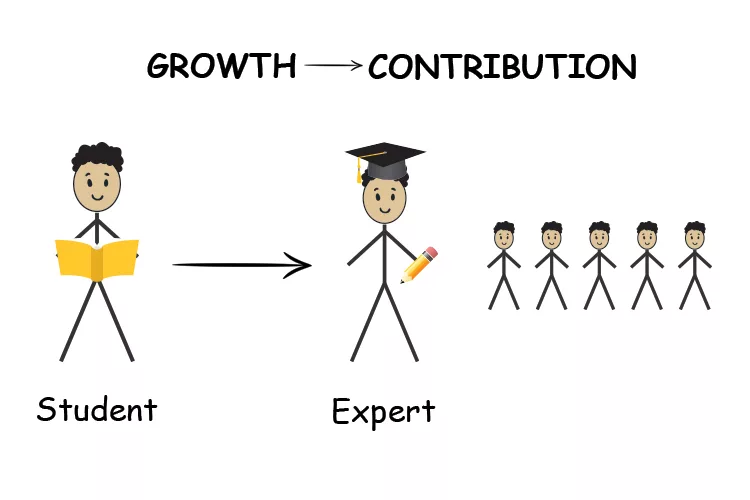
Click Here To Read Expert Secrets For Free!
2. Consider How You’ll Monetize Your Blog
Many bloggers dive into creating content without a clear monetization plan.
They focus on getting traffic.
While it’s not a bad approach, if your goal is to make money then you’ll save time thinking about monetization from the beginning.
Why?
Because the niche and audience you choose will impact how easily you can introduce paid products, services, or other monetization strategies.
So, how do you start thinking about monetization right from the start?
The Three Markets
In Expert Secrets, Russell Brunson explains a powerful way to approach monetization by focusing on the “Three Core Markets.”
These are the overarching themes that nearly every successful blog or business falls into:
- Health
- Wealth
- Relationships
Start by asking yourself which of these markets best fits your expertise.
Identifying this core market will give you a solid foundation for building a blog that can make money – because everyone wants better health, increased wealth, or stronger relationships.
Next, dig deeper to find your submarket.
For instance, if you choose the health market, possible submarkets could include diet, fitness, mental health, or skin care. For wealth, it could be investing, real estate, or online business. And in relationships, you could focus on dating advice, marriage counseling, or parenting.
Then go out and look for other successful bloggers in that same submarket.
This approach can benefit you in three ways:
- Focus on Core Desires: By tying your blog to one of the big three – health, wealth, or relationships – you’re aligning with things that people universally value.
- Discover What Sells: Checking out successful bloggers in your niche will give you insights into what kinds of products or services actually make money.
- Create a Unique Selling Point: By finding a fresh angle or unique offering within your submarket, you can carve out a new space, making it easier to monetize.
This might seem like overkill when you’re just starting.
However, researching other blogs in your niche is a real-world lesson in monetization.
Subscribe to their newsletters, explore their products, and even make a few purchases if you can.
Notice what happens after you buy: are there upsells to coaching, communities, or premium products?
Could you offer something similar?
Could you offer something better?
Taking these steps will provide insight into how other bloggers turn their audiences into income and give you ideas for crafting a monetization strategy that works.
For further inspiration on monetizing your niche, you can click below to grab a free copy of Expert Secrets.
Otherwise, let’s move on!
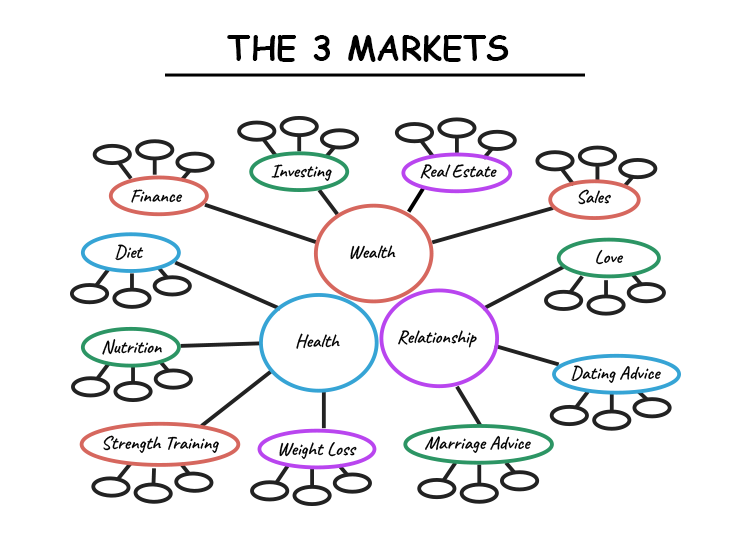
Click Here To Read Expert Secrets For Free!
3. Choose Hosting and Website Builder
Once you’ve chosen your niche and thought through your monetization strategy, the next logical step is choosing a platform to actually build your blog.
Most people who start blogging aren’t web designers or tech experts.
To launch a blog you’ll need to:
- Get a domain name
- Purchase hosting
- Find a website builder
- Choose a template
- Add basic design elements
- Review for a professional look
- Hit launch!
The sheer number of steps can feel intimidating and, honestly, can even prevent people from getting started.
So why not make it easy for yourself?
Building Your Blog the Easy Way: With ClickFunnels
With ClickFunnels, creating a blog is simple.
The platform is designed to support both beginners and experienced marketers and allows you to build beautiful, high-converting blogs without needing any coding knowledge or third-party plugins.
It’s literally “drag-and-drop”.
All you need to do is pick a theme, customize the layout, and add your content and you’re ready to go live.
Plus, ClickFunnels is much more than a blogging tool.
It’s an entire business platform that ties together your blog, website, products, CRM, email marketing, and more.
Here’s a breakdown of what makes blogging on ClickFunnels so easy:
- Establish Authority: Build credibility and establish yourself as an expert with valuable, engaging blog content.
- SEO Optimization: ClickFunnels blogs are optimized to rank well on Google, helping you attract long-term organic traffic.
- Content Repurposing: Easily turn blog posts into social media content, giving you omnipresence across platforms.
- Convert Visitors to Leads: Use exit popups, lead magnets, and sales funnels directly from your blog to capture leads and drive sales.
- Integrated Business Growth Tools: Instead of patching together multiple tools, ClickFunnels offers an all-in-one solution for building and growing your business, including email marketing to nurture readers into customers.
Using ClickFunnels for your blog means you’re not just building a blog; you’re building a fully integrated business platform.
Here’s what the back end of ClickFunnels looks like when creating your blogs:
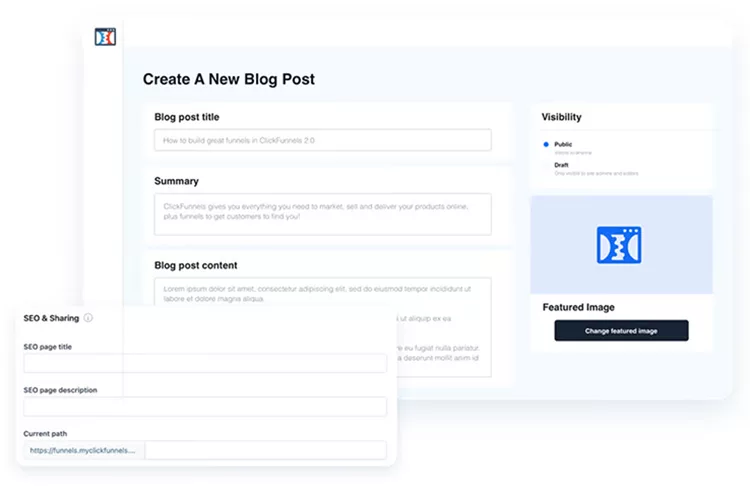
And here’s how easy it is to later monetize your blogs with products or service offerings:
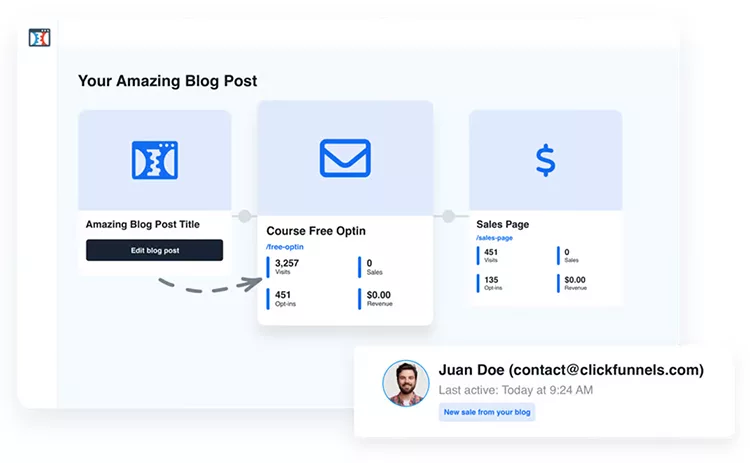
Try ClickFunnels For 14 Days For Free!
4. Brainstorm Blog Topics
Your blog topics will depend on how you’re planning to promote your blog.
If you already have an audience to tap into, then focus on creating compelling, transformative content.
To help you tell these stories in a powerful way, check out the Epiphany Bridge script in Russell Brunson’s Expert Secrets.
This script walks readers through your journey so they become invested in both your story and your products.
But what if you don’t have any audience at all?
Google Hacks to Find Blog Topics
If you’re starting out with no audience, don’t worry.
Many bloggers build their first audience through search engines, bringing in traffic (and sales) directly from Google.
The advantage of this approach?
It’s free.
By creating blog posts targeting specific search keywords, you can attract readers who are actively searching for information so they’re already primed to engage with your content.
But of course, you need to choose keywords relevant to your niche.
And… that won’t take you years and years to rank for.
So how can you find the right keywords?
In the book Traffic Secrets, Russell Brunson explains a practical, actionable method to uncover high-impact keywords through the “Dream 100” exercise.
Here’s a quick overview:
- Start with Your “Dream Keywords”: Think about the phrases your dream audience would type into Google to find the kind of solution your blog offers. Russell’s “Dream 100” keywords for ClickFunnels included terms like “sales funnels,” “digital marketing,” and “growth hacking.” Make a list of 10-20 phrases that match the products, services, or solutions your blog is about.
- Find Long-Tail Variations: Instead of focusing solely on these popular keywords (which can be competitive) look for longer, more specific versions that are easier to rank for. To do this, type one of your dream keywords into Google, and note the autocomplete suggestions that pop up – these are highly relevant, frequently searched terms related to your topic.
- Explore Related Searches: After searching, scroll to the bottom of Google’s page to see “related searches.” This list gives more ideas for closely related, long-tail keywords.
For example, if your dream keyword is “sales funnels,” you might find suggestions like:
- “Sales funnels for Shopify”
- “Sales funnels explained”
- “Sales funnels for real estate”
- “Sales funnels templates”
Following this approach, you can build a keyword list that includes specific terms your target audience is actively searching for.
And if you expand each dream keyword into 10 long-tail keywords, you’ll have a solid list of blog topics – just like Russell’s examples above – giving you a roadmap for targeted content that can attract organic traffic.
For even more depth, you can explore software tools (Russell shares a list at TrafficSecrets.com/resources) to assess monthly search volume, competition, and other metrics for each keyword, helping you further refine your list for maximum impact.
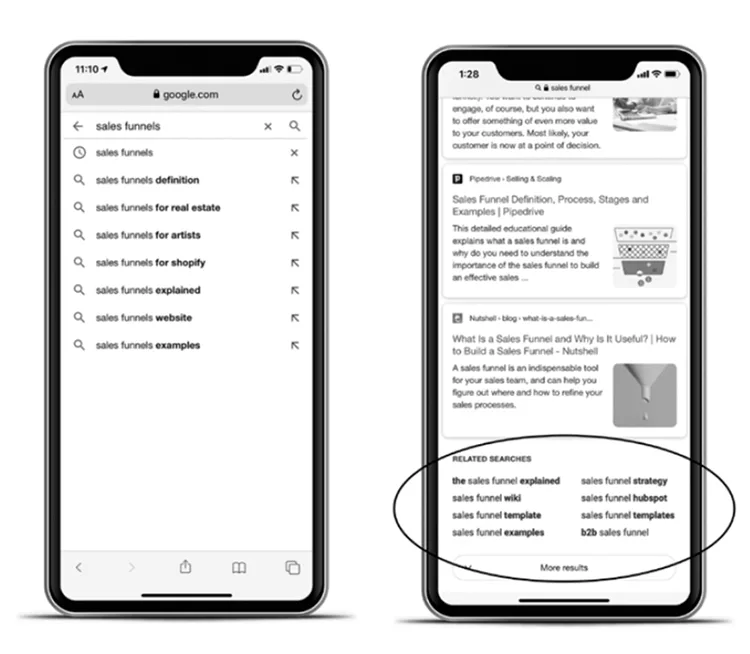
Click Here To Read Traffic Secrets For Free!
5. Setup Your Blog
In this section, we’ll walk you through setting up your ClickFunnels account, customizing the look and feel of your blog section, and getting everything ready to write your first post.
And all this in just a few minutes!
No other platform makes it this quick and easy to get your blog up and running.
Follow along with the screenshots below as we guide you step-by-step through the setup process.
Sign Up for Your Free 14-Day Trial
The first step is to sign up for your free trial of the ClickFunnels platform.
You can do this by visiting clickfunnels.com.
Then enter your email address and you’ll be taken to the page below, where you need to introduce your personal details and a card – don’t forget you won’t be charged!
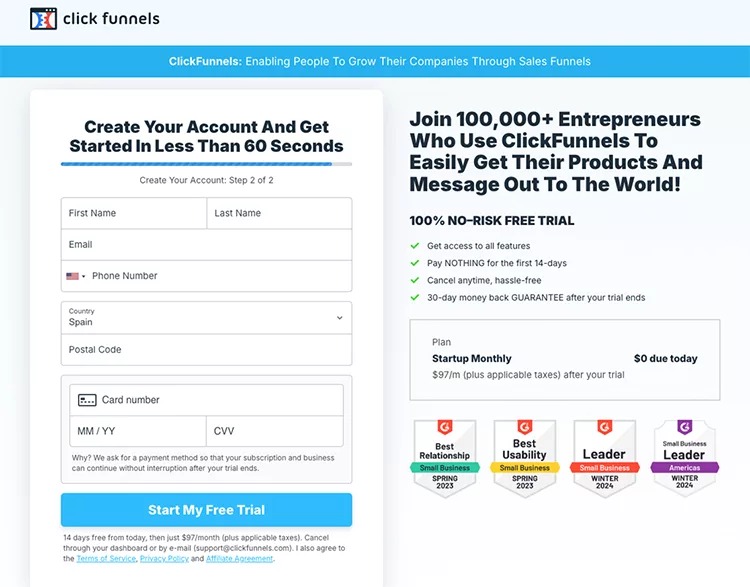
Navigate to Your New Blog Section
Within seconds you’ll receive a welcome email with a link to sign in to your new ClickFunnels account.
If you click it, you’ll be taken to the ClickFunnels dashboard.
From here, find the “Site” in the menu and then click “Blog”.
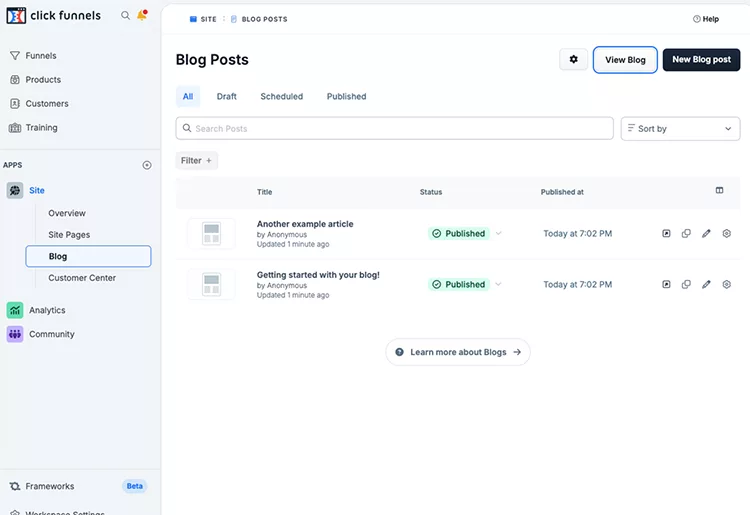
Click “Open in New Window”
Your account comes preloaded with two blog posts.
By clicking on the button that reads “Open in new window” you’ll be taken to your actual website and one of the pre-loaded blogs.
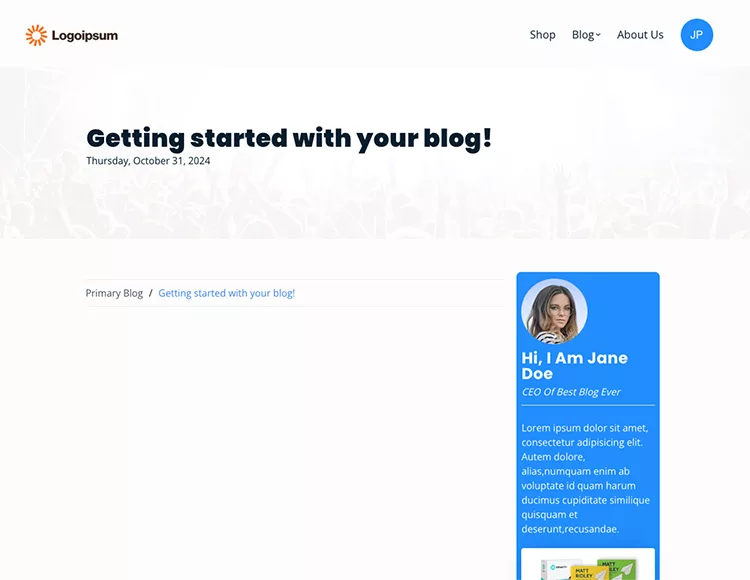
Edit Your Blog Design
The default blog template looks like the screenshot above.
But… customizing it to suit your preferences takes minutes!
Go back to the dashboard and under “Site” click the button reading “Overview”.
From here, you’ll see a button reading “Edit Site”.
Click it.
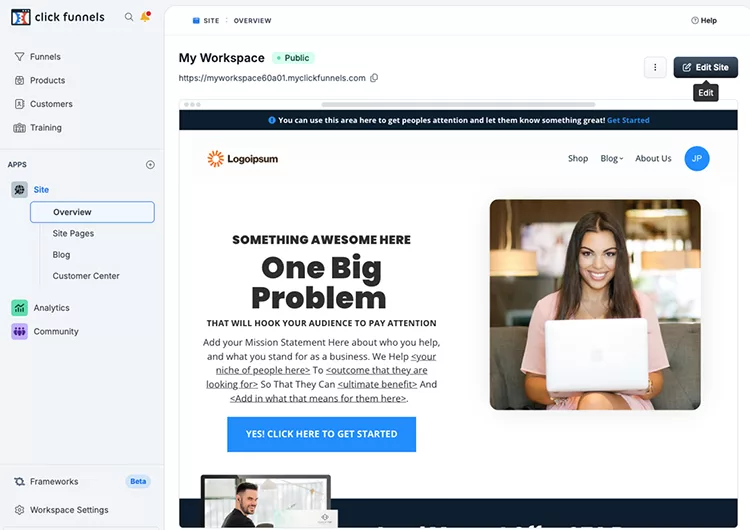
Welcome to the ClickFunnels Drag-and-Drop Editor
Now you’re inside the famous ClickFunnels drag-and-drop editor!
Later on, you can come back here to edit the homepage of your website and other elements like the header, logo, menu, products, funnels, and more.
But for now, we’re looking at the blog design.
Find the page called “Blog post” under “Blog home” in the left-hand menu and click it.
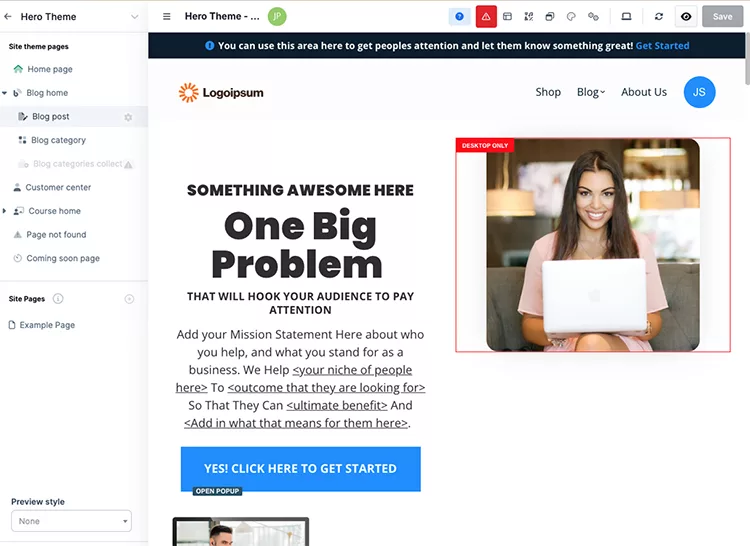
Starting Editing Elements
You’re now looking at your blog post template.
You can hover over any element to start editing it.
Just click the cog icon that appears in a colored box around the element, and you’ll find an editing window appears.
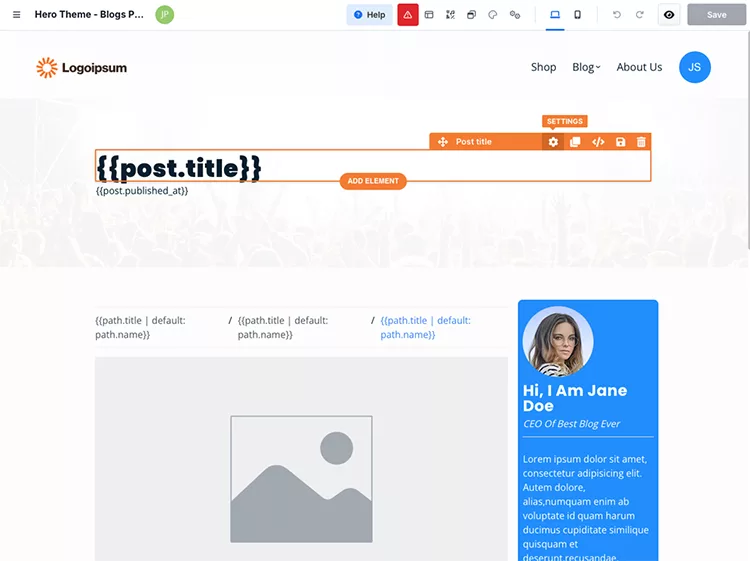
Welcome to the Editor
This new window will let you edit elements such as spacing, styling, sizing, colors, fonts, formatting, layout, and more.
For example, let’s look at editing fonts.
Just click the button reading “Edit Style”.
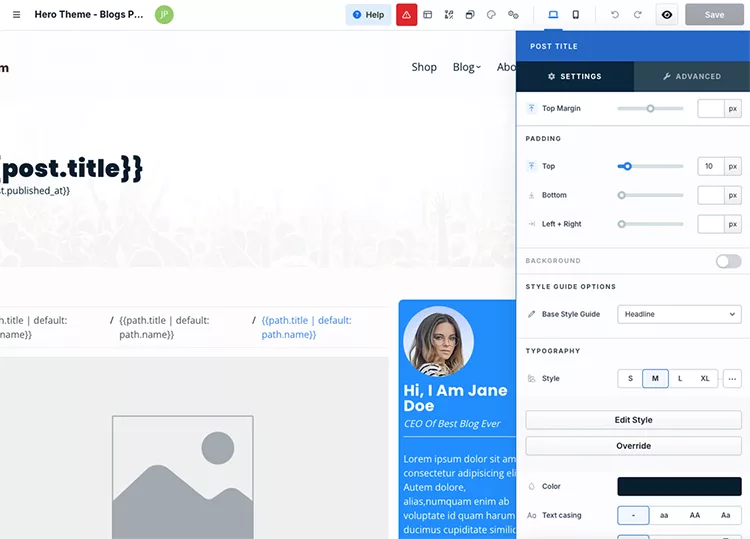
Editing Font Styles
You’ll now get a pop-up in the center of your screen.
This pop-up is called your “Style Guide”. You can edit the fonts for your headlines, subheadlines, and content here to any you like.
The changes will be reflected instantly across your website.
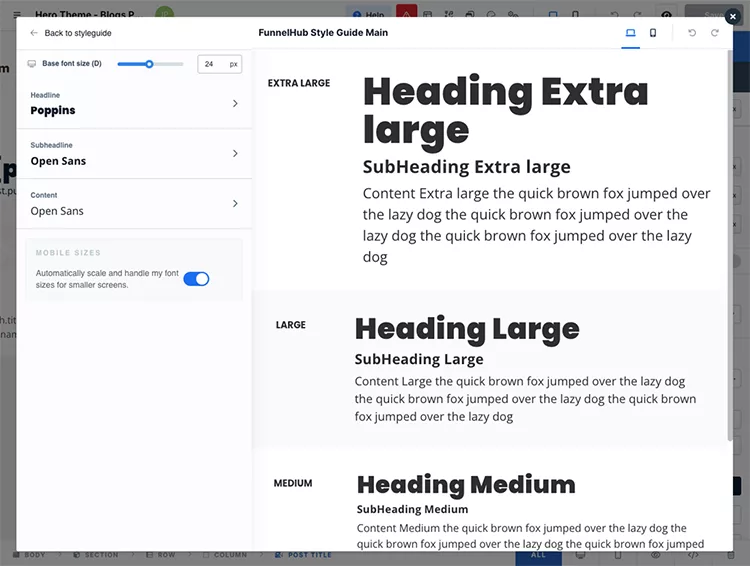
Editing Colors
To edit color schemes, simply hover over a colored element and click the cog icon.
You’ll find the side menu popping up again.
This time, click on “Edit style colors”.
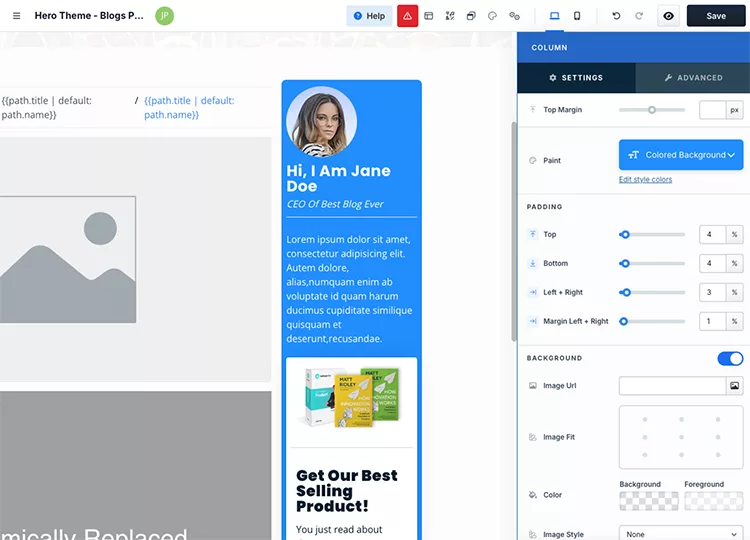
Change the Color Scheme
Here you can change the colors of major elements in your site such as backgrounds, headings, content, icons, and more.
The changes will be reflected instantly across your site.
The theme colors will always come in handy when making quick changes in the future that you want to reflect the overall design and branding of your website.
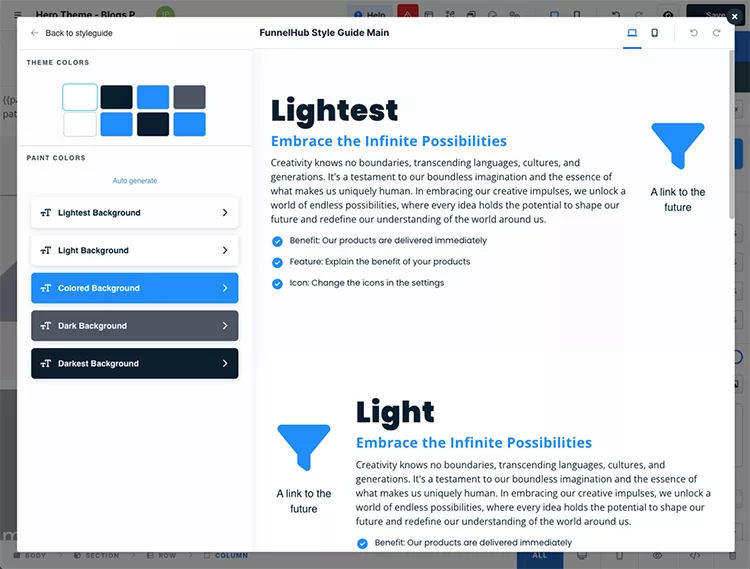
A Peek at Monetizing Your Blog
The ClickFunnels blog template comes pre-loaded with a CTA to sell a product.
You can quickly edit the text and styling of this CTA box.
But here’s where the magic happens.
If you hover over the button element and click the cog icon, you’ll see the option to change the button actions.
To start selling your own product or services, all you’d need to do is create a product in the ClickFunnels dashboard and link to it here – and you’re done!
That’s the beauty of ClickFunnels.
You get a blog, drag-and-drop website builder, sales funnel, online store, payment processor, CRM, customer center, email marketing platform, and more all in one place.
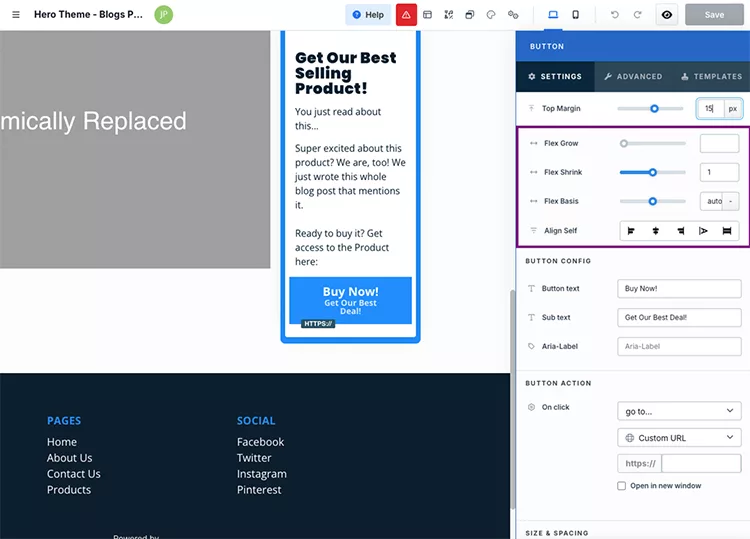
Try ClickFunnels For 14 Days For Free!
6. Write Your First Blog
At this stage, you’ve already laid a solid foundation by defining your niche, understanding your audience, planning your monetization strategies, and brainstorming topics.
Now, it’s time to create your first compelling blog post.
So, how do you do it?
How to Create an “Instructional” Blog Post
Most people search on Google with the goal of solving a specific problem, answering a question, or learning something new.
BuzzSumo, after analyzing over 100 million article titles online, found that “instructional” headlines generated the highest engagement and shares on Facebook.
In other words, these are headlines that suggest action or provide essential information.
BuzzSumo found that:
- Instructional phrases like “how to” “you need to” and “why you should” were among the top-performing headlines.
- These types of headlines communicate urgency and clarity, offering readers a direct “need to know” approach that implies important or exclusive information.
For example, popular articles included headlines like:
- “What You Need to Know About Toxic Plants”
- “What You Need to Know About the COVID-19 Vaccine”
- “Why You Should Stop Using Plastic Bags Immediately”
The key?
These headlines use “you” to speak directly to the reader, emphasizing the essential nature of the information.
They also tap into FOMO (Fear of Missing Out), implying that readers could miss out if they don’t read the article.
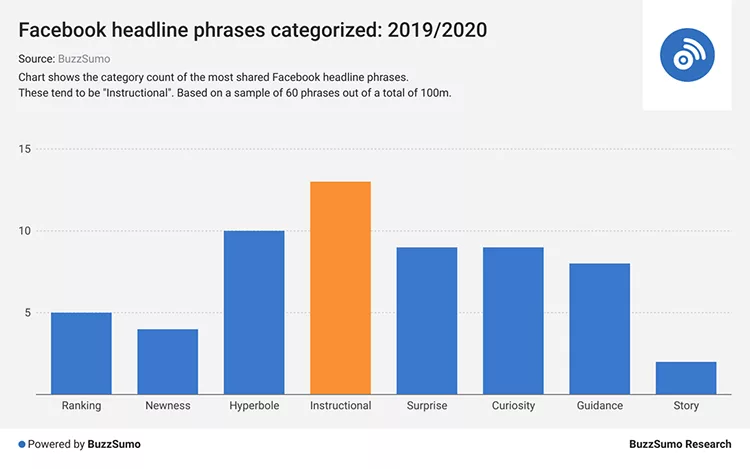
An Instructional Blog Post Headline
BuzzSumo also discovered that some of the most popular blog headlines use numbers.
These headlines promise specific, actionable information, which makes them highly clickable.
Out of the top-performing headlines, six out of the first twenty started with a number, with phrases like “X things to,” “everything you need,” or “X reasons why” also ranking high.
Here’s why numbers work:
- Clarity and specificity: Numbers in headlines tell readers exactly what to expect, and a “listicle” format makes information easy to digest.
- Curiosity and FOMO: Headlines with phrases like “X reasons why” or “everything you need” spark curiosity by promising useful or exclusive insights.
The type of blog post that includes a number in the headline is often called a “listicle”.
Listicles are perfect for creating actionable steps – like “7 Steps to Start a Blog” – and also happens to be easy to follow and retain.
For inspiration, check out popular blogs in your niche and see how they structure their posts.
Find examples you enjoy or that are already engaging readers and consider recreating their style to fit your own topic.
Finally, remember that blogging is all about practice.
Your first posts may not be perfect, and that’s okay – the goal is to keep writing, publishing, and improving.
And with ClickFunnels, it’s easy to edit your posts anytime, so you can update your content as you learn more and grow your blog.
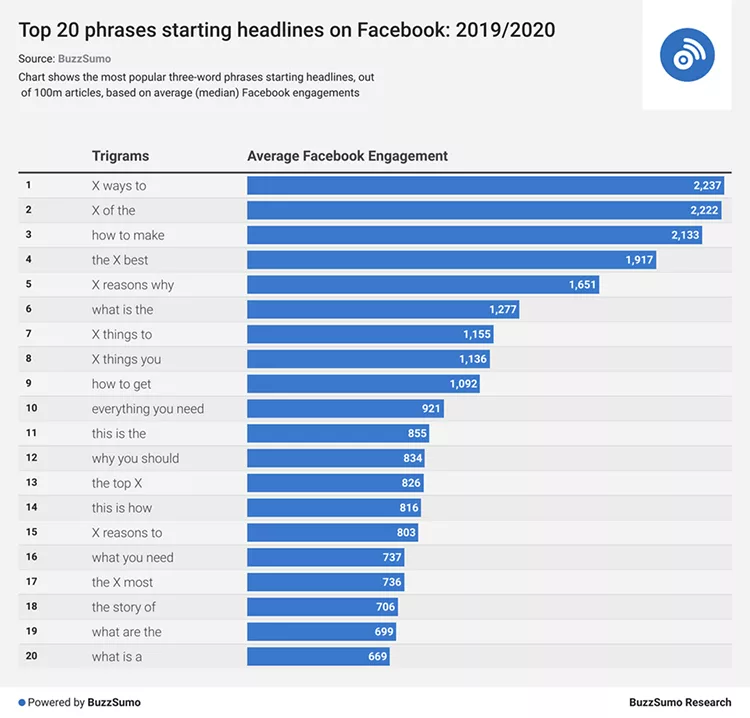
7. Promote Your Products or Services
The strategy we covered above is all about writing content that ranks on Google.
Many successful bloggers generate six-figure incomes relying solely on Google traffic, making it an excellent starting point.
Of course, there are many other ways to promote your blog posts (social media, paid ads, email marketing, influencer partnerships, video marketing, and more).
But we’re not going to get into that here.
Instead, we’ll focus on how to use your blog as a tool to promote the products or services you’re monetizing.
By strategically placing promotions within your content, you can drive conversions and revenue directly from your blog.
Here are a few ideas that you can set up within minutes using ClickFunnels.
5 Ways to Monetize Your Blog
ClickFunnels is the ideal platform for monetizing your blog thanks to its features for turning readers into leads and sales.
Below, we explore five ways to leverage ClickFunnels’ tools to monetize your content.
Each of these features is included in your 14-day free trial.
They are:
- Selling a digital product with a sales funnel: ClickFunnels makes it simple to create a sales funnel tailored to a digital product, such as an eBook, templates, or downloadable guides. Relevant calls-to-action in your blog can guide readers seamlessly into your sales funnel for conversions.
- Selling an online course: If you’re an expert in your niche, consider creating a course. With ClickFunnels, you can direct readers from blog posts into an online course funnel. Offering a free introductory lesson or mini-course as a lead magnet can be especially effective.
- Selling a membership: For ongoing value, a membership or subscription service can be a great choice. ClickFunnels enables you to set up a members-only area with exclusive content. Just ensure the membership content aligns with the topics you’re already blogging about to attract the right subscribers.
- Using landing pages to generate leads: Not every reader will be ready to purchase immediately. Capture leads by directing traffic from your blog to a targeted landing page with a lead magnet, such as a checklist or mini-guide related to your post’s topic.
- Generating leads and selling through email marketing: With ClickFunnels’ email marketing features, you can collect email addresses from blog readers and nurture them with relevant offers. Create an email series that builds trust and highlights the benefits of your products or services.
Final Thoughts: Make Money Blogging With ClickFunnels
Starting a blog requires strategy, dedication, and the right tools.
In this guide, we’ve covered essential steps – from selecting a niche and monetization strategies to setting up and promoting your blog.
But one factor stands out:
To turn a blog into a source of income, you need a platform built for monetization.
ClickFunnels is uniquely designed to help bloggers not only create compelling content but also seamlessly monetize it through funnels, lead capture, and more.
With its 14-day free trial, you can start building your blog with powerful tools that drive real results – without needing a tech background.
Ready to start a blog that works for you?
Try ClickFunnels today and take the first step toward a profitable blogging journey.
Try ClickFunnels For 14 Days For Free!
Thanks for reading How To Start A Blog And Earn Money which appeared first on ClickFunnels.
If Click Funnels is of interest and you'd like more information, please do make contact or take a look in more detail here.
Credit: Original article published here.
